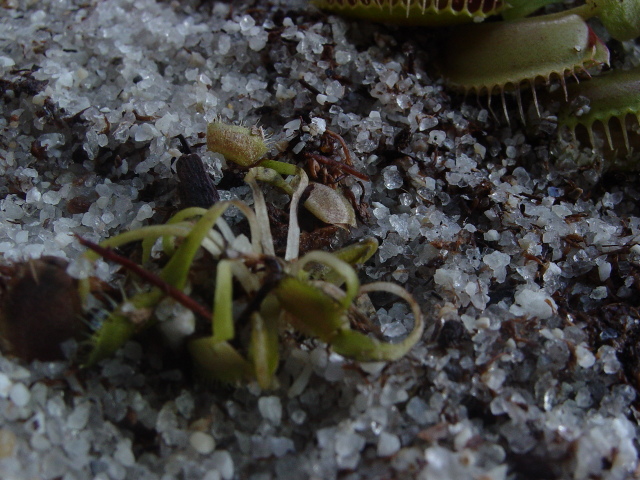Question Baby VFT
Baby VFT
QUESTION: Hey guys I find your sight useful, I particularly like the pictures of plants under 30% humidity and up to 105 degrees Fahrenheit. I live in Utah so, it gets cold and it gets hot. My baby fly traps that were purchased at flytrapstore.com were in a large pot (recently transplanted) (1 day before temperature drop)
They are in 70:30 Peat:Silica sand. All the other fly traps had minimal damage ones potted in 6-inch 50:50 silica:peat and slight variances of that. I give all my plants rain water, and distilled water. The peat I use is 100% Canadian sphagnum peat.
My question is, how do I help these plants heal from their damage. Why is there frost damage when information I have previously read says that VFT can withstand much lower temperatures than they were subjected to. Also what is the best way to help them heal, (the damage is somewhat extensive) the traps were okay, but the stems were ruined.
Some reasons I think they were more damaged. Recently replanting them gave them a lot of stress and were not able to handle lower temperatures. A larger pot took longer to thaw when I took them inside. The plants were not in full deep dormancy, they are just breaking their dormancy to grow this year. The plants in the other pots were also damaged, just not nearly as much, but damaged nonetheless, and in 28 degrees, should have been fine. According to the information on the main sight.
Don't take this as an insult or anything, was just wondering if you had any input. I'm not particularly upset about this, I just want it to be a good learning experience.
Let me know if you need more information/pictures/
ANSWER: Hi David,
The reason for the frost damage, despite that flytraps are tolerant of frosty weather, is the lack of acclimation. Think of it this way. If you were to go to Hawaii and laid on the beach all afternoon, you would develop a severe case of sunburn. To prevent this from happening, you might need to spend some time at a tanning salon developing a base tan prior to your trip. The same is true for flytraps and all temperate plants. In the wild, cold conditions don't happen overnight. The transition from summer to winter is very gradual and occurs over the course of several months as nighttime temperature gradually declines.
At our nursery, we grow our flytraps strictly outdoors, so they are already acclimated to cold conditions. I can't speak for other nurseries on how they raise their flytraps, but if they are from a warmer climate or grew their plants in greenhouses, then you will need to have acclimated the plants to cold conditions or waited until the risk of frost had passed. (I know that the nursery that you got the plants from is located in Ashland, Oregon and Albuquerque, New Mexico. In fact, one of the owners is an expert on this panel, so you can ask him directly about how they raise the flytraps. In either case, whether it be grown outdoors or in greenhouses, both locations are significantly warmer than Utah and are already in their growing season.)
To prevent further damage to your plants, grow them indoors in a south window or any window that receives at least a few hours of direct sunlight. Any damaged portion of the plant is permanent, so you'll need to wait for new growth to see normal leaves again. When the risk of frost is over, acclimate them to outdoor growing. This might be mid May for you. Of course, when it's time to move your plants outdoors, you'll need to acclimate them to full sun! For more information about the acclimation process, watch Volume 1 of the Grow Carnivorous Plants DVD series.
Good growing!
Jacob Farin
---------- FOLLOW-UP ----------
QUESTION: Hey thanks for the reply, I was also wondering why you might think the flytraps in the smaller pots received significantly less damage? Weather here is now more mild so I'm growing them outside again. Thanks for the responce I'm part of the FTS forums and know Matt and Steve, was just wondering what you guys thought about it :)
David Flocken
AnswerExposure to wind, soil moisture and closeness to the ground can affect how plants in different pots will be affected by frost. Even though plants in large pots tend to fare better, small pots are sometimes sheltered by large pots and may not be as exposed.
Jacob Farin






